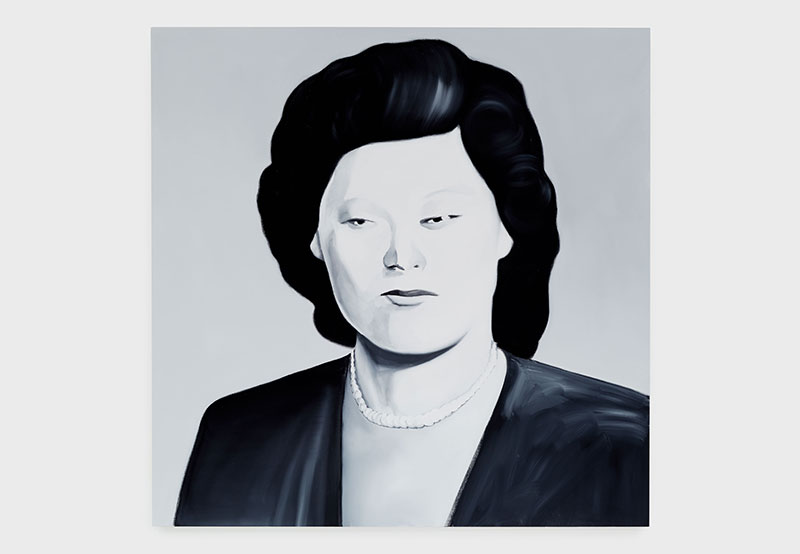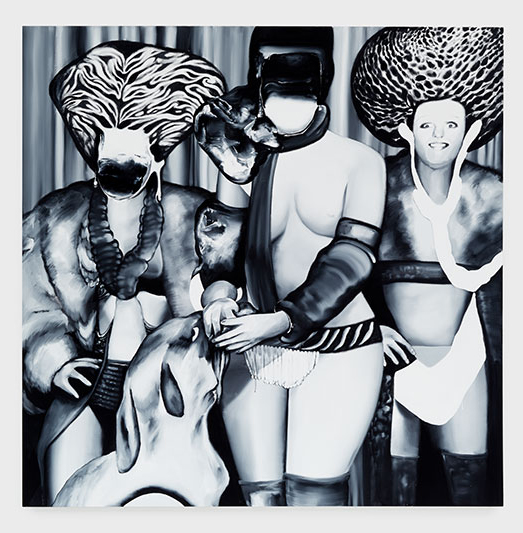Without overt intention, this has become an age of portraiture. It’s not only Instagram, but portraits precede every tweet and supervise every LinkedIn profile. Tinder and Bumble offer portrait-based dating, and any number of applications propose that you select new roommates on the basis of their looks. In this riot of signs the portrait has become a signifier: the face itself must be honest.
The first Tomoo Gokita painting to be seen, entering from the reception area of Blum & Poe, is a 76 3/8” square portrait in Gokita’s staple grayscale acrylic gouache: Daughter of a Fraudster (all works 2018). The Daughter has prepared for her portrait: her black hair has been curled away from her face, and she wears a string of pearls and an elegant blazer. But her face is poised between frown and sneer. Already she is certain she will be disappointed, either by her portraitist or, later, by the viewer.
In some ways Daughter of a Fraudster is typical of the 13 paintings in the incisively discomforting Blum & Poe show. Each is large, square and basically portraitive: human figures are arranged in stiff self-performance, often directly addressing the frame. Many, like saints or kings, carry their iconic implements: a drum, a saxophone, a beer. Female bodies—thighs, hips, stomachs—are painted with attentive-if-impatient skiagraphics; male bodies often hide in the flat bulk of their clothes. Gokita’s humans have chosen to be remembered in images.
But usually—and here Daughter of a Fraudster is one of only a few outliers—it is hard to know the characters’ feelings. That is because many of them do not have faces. A tycoon’s face has been replaced with a white blaze that spreads across the canvas; a burlesque dancer’s is a sedimentary black-to-white gradient; a dowager’s is a thick scab of black, the color less painted than pushed onto the canvas. Everywhere faces are thick melts of gray or smudged erasures.

Tomoo Gokita, Daughter of a Fraudster, 2018, ©Tomoo Gokita, courtesy of the artist and Blum & Poe, Los Angeles/New York/Tokyo.
What to make of these grim portraits, their literal defacing? Writing about Gokita’s work has tended to focus on his possible influences—his early graphic design work and his well-known connoisseurship of wrestling and pornography magazines from the analog century—and to present his current work as a natural combinatorics: what if Duchamp ran a zine?
But it seems that in a portrait economy this etiological analysis gives Gokita too little credit. For a portrait historically is a picture of power: its honesty is symbolic rather than journalistic. Napoleon crossed the Alps on a mule, but David painted him sur un cheval fougueux and four more copies were commissioned. Thrones, scepters and capes are crucial to the project: they tell us someone is king.
In Gokita’s paintings, these trappings have survived. The subjects have worn their pearls, their bow ties and bikinis. They only lack faces. And the face is also crucial: it indexes the portrait’s grammar of power. It tells us who the king is—but it is also a site of collapse. In the face, the mereness of the king or cruelty of the pope can appear. The painter is permitted to tell a human truth and the viewer permitted to pass a human judgment.
By replacing the faces with wounds, Gokita doesn’t just show the cold armature of iconography involved in portraitness—he models the violence done by the portrayal. In the construction of history it is the power that survives and the self that is broken. Gokita’s few paintings that do feature faces—the scowling Daughter, or the anxious dancer in Essential Magic Therapy—all seem desperate, on the verge of breaking.
These faces directly challenge the portrait economy—mostly an economy of performed wellness. The selfie’s subject, like the portrait’s, is arranged among icons, but now the icons—beachfront, bicep, celebrity, eggs benedict—are transient rather than permanent. The selfieur has attained them by striving, but soon time will take them away. Here the face operates: it is effortfully attractive and delighted. It is disturbed neither by the effort of attaining nor the precariousness of the attained. The selfie is a performance of affective power: the power to have been invigorated by late capitalism. Gokita’s subjects are wiser, and essential in their wisdom. The few smiles in the show—vicious in Don’t Talk About Me, ecstatic in Time After Time, or serene in Living at Home—tend to belong to faces that have already begun to disintegrate.


